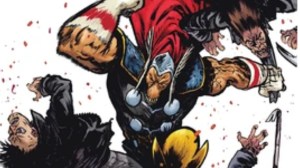
Matt Wilson is the Todd Klein of coloring. Despite my aversion to comparing different forms of art, I hope the comparison and compliment holds water. Wilson, like Klein, is a comics artist capable of working on many series regularly with a stunning, easily recognizable style in each that enhances the wildly varying work of many different writers and artists. The work is simultaneously outspoken and chameleonic, consistently bold in its craft and a team player within the comic. After the better half of a decade reviewing Wilson’s work, it stands to reason that he has the sort of talent that could collect almost as many Eisners as the, seemingly unstoppable at 17, Klein. Regardless of what reward shows decide, Wilson’s work as a colorist has been outstanding for year and it is worth pausing to consider one of the key elements that has made his contributions of the form indispensable.
Videos by ComicBook.com
That element is Wilson’s adaptability. Most comics read in the direct market are a team effort, normally composed of a half dozen creators (i.e. writers, artist, colorists, letterers, often featuring more than one person in some roles). Unlike the work of an individual cartoonist, these individuals must not only deliver their own best work, but must translate that work to accent and enhance that of others. It’s no easy feat. Wilson has regularly developed variations on his own style which amplifies the work of other artists and often creates a tone unique to the overall narrative. One needs look no further than the recently concluded Paper Girls, a series that took the already recognizable comics stylings of Cliff Chiang and Brian K. Vaughn and delivered a series unlike anything either had produced before. Wilson was an integral component in Paper Girls from page one, and the series we have would not be the series we know.
It’s worth considering a spat of Wilson’s other recent work to recognize just how versatile his vibrant palette can be.

The White Trees #1
I touched on this theme of collaborative enhancement earlier this week in my review of Wilson’s most recent publication, The White Trees #1. The second page of the issue introduces a capitol city rising above the mist. Artist Kris Anka does an excellent job of initially rendering this city, delivering a clear style of architecture, a perspective bound to induce Spielbergian awe, and clearly layering details based upon distance, providing the illusion that the city is receding in less-than-crystalline air. Wilson recognizes that this one panel is intended to provide the sense of looking at an entire city without suffocating readers in detail and provides exactly what is needed to complete the illusion.
The sun’s arc is clearly carved behind the perspective point of this panel within the shadows on each layer of the city. The closest buildings with the most definition create shadows that are recognizably attached to many distinct units. As both the sun and reader’s eye travel further, these shadows blur and morph. They still provide slow curves and enough texture to cast the illusion that this level of definition could be found upon closer examination of the entire city. There is no doubt that within these walls rests a thriving populace with its own unique culture and economy. The way in which further layers of refraction are considered as light travels through the clouds of the misty city reads as though Wilson is dusting off his shoulders.

The Wicked + The Divine #44
That sort of approach to coloring would be enough to make for an esteemed career with ample opportunities for collaborative success. It’s also what makes Wilson ability to restrain and flatten his approach all the more impressive. The penultimate issue of The Wicked + The Divine, a climax more than five years in the making, was recently released and didn’t exhibit the same flair witnessed throughout The White Trees #1.
The narrative here doesn’t demand flash, instead it focuses primarily on characters reckoning with internal conflicts and a few key decisions. The emphasis needs to be placed on the faces and gestures of the characters, not the still impressive cityscape behind them. Much of the issue falls into darkness as a result with many background composed of nothing beyond a spattering of lights. Yet even in those lights rests a careful pattern, as they provide suggestions of changes in landscape and neighborhood zoning, still offering readers a sense that the entire world is continuing to move with all of its incumbent sounds, smells, and feelings that can only be implied in comics. Wilson limits the texture of his work in the characters as well, matching artist Jamie McKelvie’s focus on providing clear, essential lines that render forms and faces instantly recognizable. Wilson fits his work to the needs of a story that is radically different, in both tone and presentation, seemingly as easy as he might change outfits.

The War of the Realms #6
Beyond his successes in many creator-owned projects, Wilson has shown that he still has a knack for delivering some of the best superhero fare available in 2019. The War of the Realms delivered a slamdunk of a summer event, living up to its considerable hype and excessive crossovers. In addition to the typical character density, many action sequences, and extended page counts that come with an event, this one also focused on Thor and thus needed lightning to carry force and weight, despite often appearing as a crackling, white void on the comics page.
Wilson’s palette choices in blending edges of lightning and energy into surrounding artwork are perfect. Blues and violets coming from the far end of the visible spectrum with shorter wavelengths provide a hint of necessary color. The use of blurring effects, like those in the panel above, are judged in just the right fashion as to make the energy effects hum without making surrounding colors appear muddy or losing too much form. The War of the Realms crackles across all six issues with Wilson’s approach to electric action.
Reviewing these recent examples of work, it’s clear why Wilson is not easily forgotten as a colorist. Wherever he appears, Wilson brings both his own style and insight on how it works best alongside that of collaborators. It ensures that he can work within a variety of projects, including both best-sellers at Image and Marvel within a few weeks of one another. That’s why Matt Wilson is already a name recognized in comic book stores everywhere.








